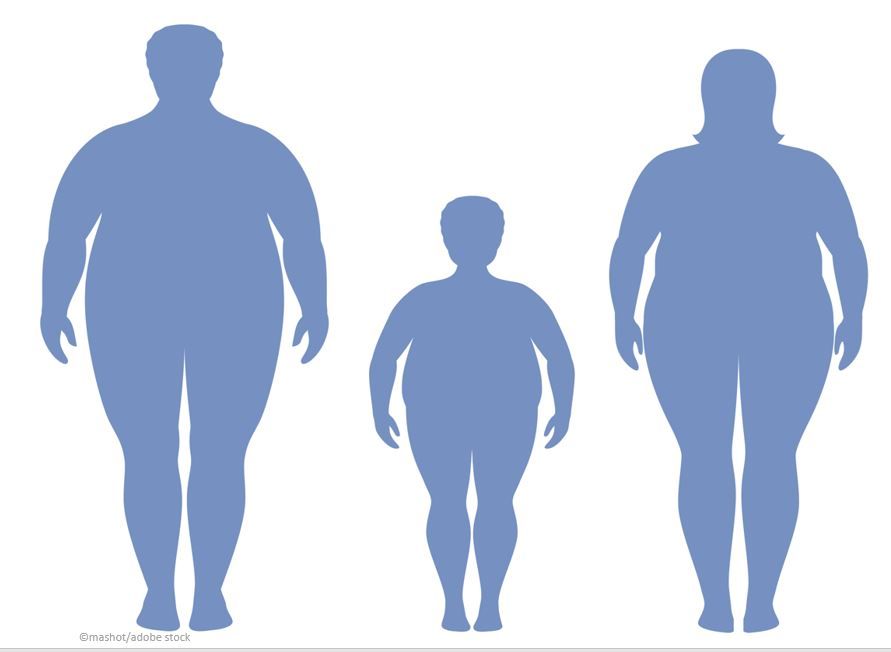Obesity and the Musculoskeletal System: Age and Impact
Excess weight diminishes the development and function of the musculoskeletal system at any point in the lifespan. An obesity specialist highlights the dangers.

Obesity is a deeply intricate and complex disease that affects virtually every aspect of a patient’s body with the potential to cause other serious health issues. Excess weight can impact patients’ musculoskeletal systems in a variety of ways throughout the stages of growth. Fully understanding the spectrum of connections and risks is vital to providing the best overall care for patients with obesity.
Long-term impacts
Physical force causes stress on body tissues and joints, and excess adiposity, or ‘central fat,’ can lead to immobility, tissue compression, and tissue friction (intertrigo). Intertrigo is common in the body’s warm, dark places, such as in the abdominal fold, under breast folds, and in the groin.
Some long-term impacts of obesity on the musculoskeletal system include back pain, ranging from the cervical to the lumbar spine. When more fat is deposited in the abdominal area, the back must compensate, which adds curvature to the spine.
An unhealthy BMI can also cause pain and osteoarthritis, particularly in weight-bearing joints, such as the knees, hip, and spine. In these cases, medication should be used as needed for pain management to increase mobility as unmanaged pain increases the chance for an even greater decrease in physical activity. While weight reduction, even as little as 5-10%, can improve patients’ overall wellness and reduce health risks, once joint damage occurs, weight loss alone is unlikely to reverse it.
Other long-term impacts of obesity on the musculoskeletal system include an increased risk for gout, a decline in balance, the development of flat feet, and overall reduced mobility.
Common misconceptions: Physical activity vs exercise
Physical activity and exercise are the main pillars in both the development and treatment of obesity. Given the severe limitations on activity obesity can cause, some patients believe that they won’t be able to incorporate physical activity into their weight loss routine. But there’s an important distinction between physical activity and exercise. Physical activity includes everyday movement like gardening, housework, climbing stairs, and walking. Exercise, on the other hand, tends to be structured, planned, and is thought to improve physical fitness.
Patients are often concerned, too, that a gym membership and exercising 3 to 5 days a week are required to achieve results and that they won’t be able to manage this. But there are many great options for physical activity that don't require high levels of exertion. For persons with overweight or obesity who have decreased mobility and flexibility, seated exercises and water fitness programs include joint-friendly movements that wouldn’t otherwise be possible.
Healthcare providers may also hold this misconception about exercise requirments. Many believe that increased activity can help lead to greater weight loss, when in fact increased activity/exercise has been shown to be more beneficial for maintaining weight after weight loss versus aiding in initial weight loss.
Musculoskeletal health, obesity, and pediatric and teen patients
The impacts of obesity on the musculoskeletal system begin early and can be observed in pediatric and teen patients. According to the American Academy of Orthopedic Surgeons, excess weight can cause vitamin deficiencies, hormonal imbalances, and increased stress and tension that can affect bone growth and overall musculoskeletal health, causing deformity, pain, and, potentially, a lifetime of limited mobility and diminished quality of life. For growing youth, overweight and obesity can seriously impact the growth and health of bones, joints, and muscles.
Excess weight can damage growth plates, which regulate and help determine the length and shape of a bone at full growth. The added stress on the growth plate can precipitate early arthritis, a greater risk for broken bones, and other serious conditions, such as slipped capital femoral epiphysis and Blount's disease, the bowing of legs that can lead to irregular growth and deformity.
Children and adolescents with obesity, like adults, also have an increased risk of developing flat feet, which can hinder the ability to walk long distances without pain. Behavioral responses related to the fear of pain over time can increase the likelihood of withdrawal and an increasingly sedentary lifestyle. Obesity also can impair balance in younger patients, leading them to limit participation in routine physical activity like jumping and running, which can then lead to embarrassment, isolation, and the development of mood disorders.
Musculoskeletal health, obesity, and aging patients
The process of aging impacts the musculoskeletal system regardless of a patient’s weight. The effects, however, are amplified in aging patients with unhealthy BMIs. Women lose bone density as they age, making them more prone to fall fractures and excess weight can accelerate bone loss. Vitamin D, which is vital to bone health, has also been shown to be lower in patients with obesity and is further affected by the aging process.
Interestingly, there seems to be a decrease in fall risk in the aging population with obesity, possibly due to decreased mobility and “extra cushioning” in the event of a fall.
Each of our patients with obesity has unique health goals. Fully appreciating the significant connections between obesity and the musculoskeletal system will help us better help them to achieve those.
Ongoing education is critical in our fight against the obesity epidemic. The Obesity Medicine Association provides the latest obesity treatment resources and tools to help providers guide patients toward better health. Learn more: https://obesitymedicine.org/.
Tori Butur, MSN, APRN, FNP-BC, currently practices at North Shore Primary Care in Libertyville, IL. In addition to being a primary care provider, she provides medically managed weight loss care for patients with overweight and obesity. Butur is a current member of the Illinois Obesity Society, American Society for Metabolic and Bariatric Surgery, the Illinois chapter for ASMBS, the Obesity Medicine Association, and the International Federation for the Surgery of Obesity and Metabolic Disorders.